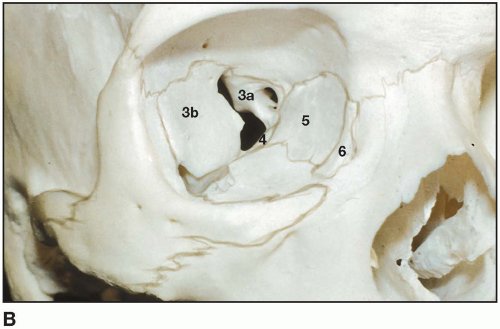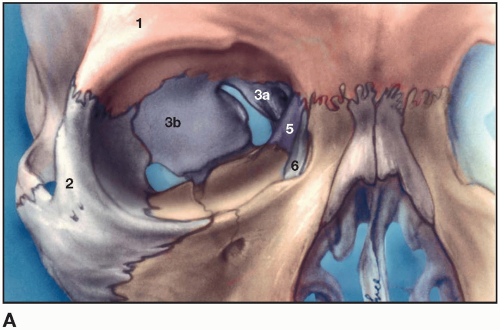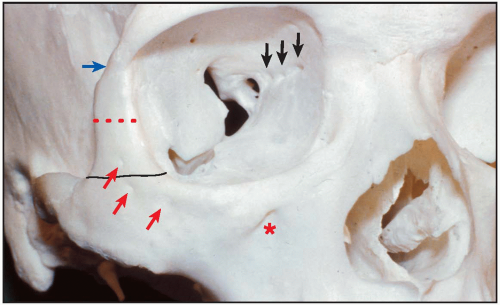
Figure 1.3 The walls
The roof. This wall is composed mainly of the orbital plate of the frontal bone. Posteriorly, it receives a minor contribution from the lesser wing of the sphenoid bone.
Located within the anterolateral portion of the roof, note a smooth, wide depression for the lacrimal gland, the lacrimal fossa (LGF). Approximately 5 mm posterior to the medial aspect of the rim, the trochlear fossa (TF) denotes the attachment of the cartilaginous pulley for the tendon of the superior oblique muscle. The triangular roof narrows as it proceeds toward the apex, where a vertically oval opening, the optic foramen (OF), marks the orbital end of the optic canal.
The lateral wall. The lateral wall is formed primarily by the orbital surface of the zygomatic bone (Z) and the greater wing of the sphenoid bone (S).
A small, bony promontory may be noted just within the orbital rim. This important landmark, Whitnall’s tubercle (WT), is the point of attachment for several structures 11 mm below the zygomaticofrontal suture. At the anterior end of the inferior orbital fissure, a small groove may be noted for the passage of the zygomatic nerve and vessels. The groove often develops into a canal that divides within bone to conduct the zygomaticofacial vessels and nerves onto the face and the zygomaticotemporal vessels and nerves into the temporal fossa. The zygomaticofacial and zygomaticotemporal complexes may pass through separate foramina.
The floor. The inferior orbital fissure (IOF) separates the greater sphenoid wing portion of the lateral wall from the floor. The fissure communicates with the pterygopalatine fossa as well as the infratemporal fossa. Through this fissure pass (1) the maxillary division of the trigeminal nerve, V2, and its branches; (2) the infraorbital artery; (3) branches of the sphenopalatine ganglion; and (4) branches of the inferior ophthalmic vein to the pterygoid plexus. The thin orbital floor is composed of the orbital plate of the maxilla, the zygomatic bone anterolaterally, and the orbital process of the palatine bone posteriorly. A shallow rough area at the anteromedial angle (OBL) marks the origin of the inferior oblique muscle. The infraorbital groove runs forward from the inferior orbital fissure. Anteriorly, the groove becomes a canal within the maxilla, finally forming the infraorbital foramen on the face of the maxilla. The groove and canal transmit the infraorbital nerve and artery. From the lower aspect of this nerve, middle superior alveolar nerves (occasionally) emanate to supply the bicuspid teeth. More anteriorly and 5 to 20 mm prior to the infraorbital nerve exit from its foramen, the anterior superior alveolar nerves descend medially along the inner face of the maxilla or within a canal to supply sensation to the anterior three teeth and gingiva.
The medial wall. The medial wall is quadrangular in shape and is composed of four bones: (1) the ethmoid bone centrally; (2) the frontal bone superoanteriorly; (3) the lacrimal bone inferoanteriorly; and (4) the sphenoid bone posteriorly. The inferior orbital margin continues upward into the anterior lacrimal crest (ALC), part of the frontal process of the maxilla. The superomedial margin continues downward into the posterior lacrimal crest (PLC) part of the lacrimal bone. Between these rests the fossa for the lacrimal sac (LF). Usually, the fossa is approximately 14 mm in height.
The medial wall is quite thin, and the ethmoidal portion has been termed lamina papyracea. The anterior and posterior ethmoidal foramina (AE, PE) are noted at the frontoethmoidal suture and denote the level of the cribriform plate. The anterior ethmoidal foramen transmits the anterior ethmoidal artery and the anterior ethmoidal nerve branches of the nasociliary nerve. The posterior ethmoidal foramen provides a passage for the posterior ethmoidal artery and, occasionally, for a sphenoethmoidal nerve branch from the nasociliary nerve. |




 Get Clinical Tree app for offline access
Get Clinical Tree app for offline access



